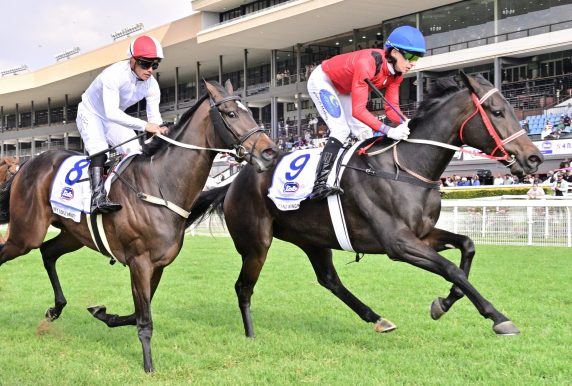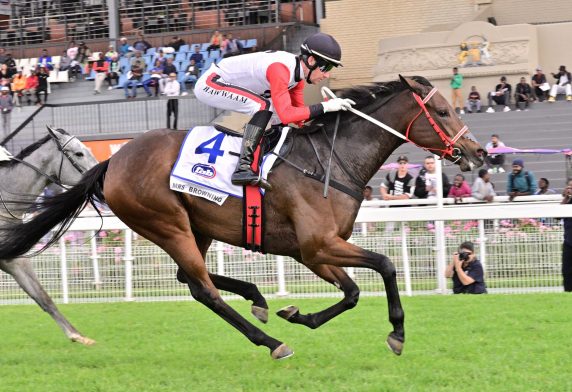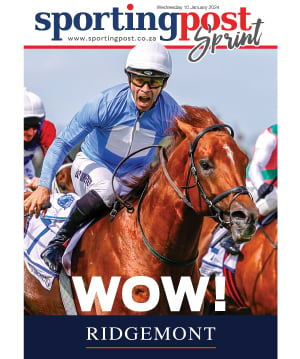I did a lot of my initial research on the Equine Wobblers and Seattle Slew websites and the more I read, the more amazed I became at the parallels between the two horses and the two stories, reports ROBYN LOUW.
The similarities are staggering and become even more so as the story runs its course. Both horses were purchased for relatively modest sums and both were bought with a little female intervention. Karen Taylor reportedly elbowed Mickey hard in the ribs to persuade him to stay in the bidding to the eventual purchase price of $17,500 for Seattle Slew. In much the same way that Mrs Devine ‘assisted’ her husband in making the deciding bid of R15,000 on Jet Master !
In her piece for American Turf Monthly, Ellen Parker wrote ‘There is, from time to time, a great love affair between man or woman and horse, whether we are talking about the little girl down the road who loves her pony or the obvious love John Nerud had for Dr. Fager. Having witnessed such love, we know it exists, but it may have existed in its purest form between Karen Taylor and Seattle Slew.’ And I think there’s more than a little of that feeling between Jet Master and the Devines.
When Slew started showing ‘wobbler’ symptoms and required spinal surgery in 2000 and again in 2002, Karen and Mickey Taylor sold their home in Washington and moved to Kentucky to be with him. And when Jet Master presented with what looked like similar symptoms earlier this year, the Devines moved heaven and earth to assemble the same team who helped Seattle Slew.
Pay It Forward
It is odd how events that seem independent and entirely unconnected on the surface, can come together in the most unexpected ways. When Seattle Slew won the American Triple Crown series in 1977, the Taylors donated to a research fund at the College of Veterinary Medicine at Washington State University. Their funds supported the development of surgical techniques for the treatment of spinal cord compression and would benefit Seattle Slew when required treatment for his own spinal cord compression years later. Interestingly, Washington State University is also the alma mater of 4 members of Seattle Slew’s surgical team, including one Dr Barrie Grant.
Dr Grant is a specialist equine surgeon, board certified by the American College of Veterinary Surgeons. Through a close association with Dr George W. Bagby, a human practitioner and the inventor of the Bagby basket, Dr Grant transferred the technique of cervical arthrodesis to the veterinary world to treat horses with spinal cord compression. The ‘horse version’ of the basket became renamed as the “Seattle Slew” basket. Dr Grant has gone on perform the highest number of wobbler surgeries in the world and is considered the leading authority in his field.
Devine Intervention ?
Professor Olivier Lepage is a specialist equine surgeon, board certified by the European College of Veterinary Surgeons. He is Head of the Equine Department at the Veterinary Campus of the University of Lyon. Professor Lepage met and consulted with Dr Grant on cervical arthrodesis surgery in France and subsequently acquired 10 years’ experience with this surgery himself. When he was invited to give lectures at the 30th World Veterinary Congress which was held last October in Cape Town, he decided it would be a nice opportunity to take a sabbatical from University and started casting around for a suitable opportunity. He says he made enquiries at two local equine practices and received a reply from Drakenstein Veterinary Centre the same day. Not long afterwards, he and his charming family were installed in the Western Cape.
When Jet Master started showing wobbler symptoms, Drakenstein Veterinary Centre was consulted. And when it was decided to investigate whether Jet Master had suffered spinal cord compression and potentially perform a cervical arthrodesis in South Africa for the very first time, it seemed fate that Dr Barrie Grant was enlisted to help and the surgical procedures were scheduled to take place at DVC.
The Myelogram
I explained in last week’s column that the process consisted of 2 parts. The first was a myelogram which is a diagnostic procedure whereby dye is injected into the spinal canal and a series of radiographs taken to determine the presence of any lesions (compressions of the spinal canal). This procedure is performed under general anaesthesia and needs a careful, assisted recovery. I am pleased to report that this was a success and the myelogram showed a severe compression at Jet Master’s C6-C7 joint. Interestingly, the same site as Seattle Slew.
Anatomy 101
For those of you who do not know, the horse’s spinal column does not follow the outline of the horse’s body the way ours does and their 7 cervical (neck) vertebrae are actually arranged in an S shape, joining the trunk approximate half way down between the shoulder blades. With the C6-C7 joints being the last in the column, you can therefore understand that they are situated fairly deeply in the horse’s body.
Spinal Fusion
The second part of the procedure is the more serious surgical procedure which effectively entails fusing the joints at the compression site. A hole is drilled in one side of the vertebral column where the C6 and C7 vertebrae overlap and a specialized titanium rod is inserted to pin the areas together. Correctly performed, the bones then heal by growing through the basket and fuse the joint. And by stabilizing the joint, you eliminate the compression of the spinal cord.
With a definitive diagnosis and confirmed compression site, the team scheduled surgery for Saturday morning.
Jet Master
I popped round to meet Jet Master and interview the team on Friday evening. Having never met Jet Master in person, I was not sure what to expect, but suffice to say he surpassed anything I could have imagined. I am used to large Warmblood horses, but he is colossal ! I could not get over his phenomenal bone and fantastic proportions, still exuding strength and power. And despite his current difficulties, he seemed remarkably accepting and at peace with what was going on. He put his head to the grill in his door to check me out and let me stroke his head, before going back to snuffling around his bedding.
He was in the ICU stable, which is large and roomy and well bedded with a view out into the hospital. A temporary pen has been rigged up so that his companion pony can be kept in his line of vision. One side of his stable wall has a large glass observation window and a little anteroom where a cot bed was set up for his groom, so that he can be monitored around the clock.
The Team
It is my eternal good fortune that the Louw Flyer allows me access to some extraordinary people and it was a rare privilege to meet and spend time with Professor Lepage and the DVC team as well as Dr Barrie Grant and his team. They sketched the procedures for me, showed me the Bagby Basket and demonstrated how it would be inserted on an anatomical model. I saw Jet Master’s myelogram images and his compression.
The team all took turns to explain their areas of expertise and it quickly became clear that despite only working together for a few days, the team had gelled into a very cohesive and tightly knit unit. It was one of those examples where the whole was so much more than simply the sum of its parts.
It is always a rare treat to spend time in the company of people who are good at what they do, and despite the circumstances, it was a fascinating evening.
I was extended an invitation to attend Saturday’s surgery and left with butterflies in my stomach !
D-Day
Saturday dawned bright and sunny and I made sure I was at the hospital in good time. I’m not sure one can appreciate quite how big and heavy a horse is and how many people are required to perform a successful surgical procedure. Aside from Dr Grant and Professor Lepage, they were assisted by Dr Andrew Gray (who I must mention is the first local veterinary candidate to follow a European College of Veterinary Surgeons Equine Surgery training programme, which he is completing under the supervision of Prof. Lepage). Dr Robin Moore was the anaesthetist, Jan Sargent-Beach was the veterinary technician and general operating theatre coordinator extraordinaire. There were two additional vets – Dr Donald MacRae and Dr Pia Rasmussen – to assist with general theatre procedures including intraoperative radiography, Michelle Gerber (a second vet tech from DVC) and Jan’s husband Craig who photographed the surgery.
The team assembled early to run through the clinical checks and talk through the procedures one more time. Jet Master had already had his mane neatly plaited and his throat shaved in preparation and seemed entirely unperturbed by the big occasion. At 9am Dr Moore did a quick clinical exam to check that Jet Master’s stats were within normal limits . Because of Jet Master’s previous operations for a left laryngeal hemiplegia, Dr Grant had opted to operate from the left hand side, which added a few additional complications.
Once everyone was satisfied, Jet Master was brought out of his stable and had his mouth and feet thoroughly washed to ensure there were no bits of food left that might obstruct the breathing tubes or foreign material to contaminate the operating theatre.
He moved slowly and deliberately and the team had to help support him to make the 90 degree turn into the padded knockdown room. I felt so sorry for him that those great, powerful hindquarters that have always been the source of his speed and power were letting him down so badly. But he managed with as much grace and dignity as he could.
They then put him into the specially imported Anderson sling in preparation for the anaesthetic. I have to say, the sling is quite an incredible piece of kit. It has been thoughtfully designed with lots of sheepskin padding to protect joints and prevent any rubbing. The sling is connected to a series of hooks which then connect to a frame and that in turn is suspended by a pulley mechanism from the ceiling. The hooks and clips are all colour coordinated to make it easier to use. Once Jet Master was securely hooked up, the doors were closed for the anaesthetic to be administered. I made my way to the viewing area and at 11am watched as Jet Master was wheeled into the operating theatre.
One does not often see horses lying on their back and the sight is somehow offensive to the sensibilities – it is just not right somehow. Jet Master is a huge horse, but if it is possible, he looked even bigger laid out on his back. He was laid out on the operating table with thick surgical sponges arranged to support him and hold him securely in place.
I was fortunate to have Mrs Grant act as my guide through the surgery and she explained every step in the process. The team meticulously measured and marked the proposed incision site, checking and making minute adjustments all the while to ensure everything was 100% correct.
Once the final prep had been done, the surgical drapes put in place and everyone scrubbed up one last time, the first incision was made at 11:40. It was amazing to see how well everyone worked with and around one another. Dr Moore monitored Jet Master’s vital signs like a hawk, Jan managed to conjure up tools and equipment intuitively and vanish them just as efficiently once their job was done. She also did a sterling job at breaking the tension, keeping everyone relaxed, but focused on the job at hand. With the team crowded around the table, it was hard to see specifics, but despite every minute feeling like an eternity, everything ran like clockwork and actually went surprisingly fast.
It took about 40 minutes to get through the layers of muscle to where they needed to be. At 12:20 they started excavating the space for the basket. The basket went in at 12:30 and by 12:35 the team started to suture the layers back together again. Fifteen minutes later it was all over and at 12:50 Dr Gray put in the last of the skin staples. At 12:55 they applied the bandage and took a final set of X-rays and at 1pm Jet Master was wheeled back into the knock-down room to recover.
After Prof. Lepage did an ultrasound guided injection of the C6-C7 articular facets, they let him rest on the ground for a little and once he showed signs of the anaesthetic wearing off, they hooked the sling back up to the hoist. By 13:30 they had him upright, suspended by the sling and everyone stood around anxiously watching and monitoring as he slowly came round. I think this was the most anxious time for everyone, but with the assistance of the sling, it seemed to go remarkably smoothly. At 14:10 Jet Master opened his eyes and was starting to support his own weight on his front legs. He was still groggy, but very quiet and relaxed, giving long snorts from time to time. By 14:20 Professor Lepage removed the front leg straps, followed by the back ones at 14:30. The neck support came off at 14:40, the tummy sling by 14:50 and by 3pm Jet Master was supporting himself fully.
Once everyone was satisfied that he was quiet and happy to support his own weight, they closed the doors again to keep it dark and allow him to recover quietly on his own. Everyone hung around nearby though, chatting quietly, but not quite yet ready to move too far away from him.
Recovery and Rehabilitation
Dr Grant explained that the spinal cord is like a tube of toothpaste and like a tube that has been squashed in the middle, it will take some time for the nerves to repair and regenerate. The extent of the recovery is uncertain and depends on the extent of the damage caused by the compression as well as getting treatment as fast as possible, so we will potentially not know how successful the surgery has been for some months.
However, the good news is that the team was very satisfied with how the surgery went and Jet Master certainly has the odds stacked in his favour.
Where to from here ?
On Sunday morning, Jet Master suffered a serious setback in his condition and was placed in the sling again. Dr Grant flew back to America on Monday afternoon and has handed Jet Master over into the care of the DVC team. The stallion is still in high intensive care day and night and his condition monitored constantly. It is still too early to assess how fast he will recover from this last episode, but if everything goes well, he will need 60 days of box rest and thefull recovery process may take up to a full year, so there is still a long road to travel.
*
Footnote: One day on, Jet Master succumbed








